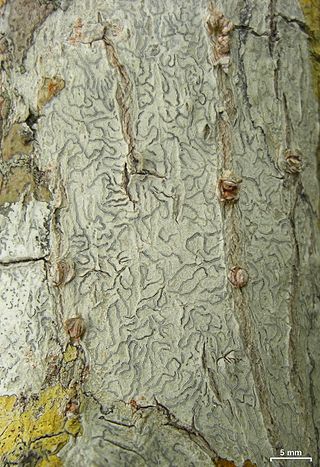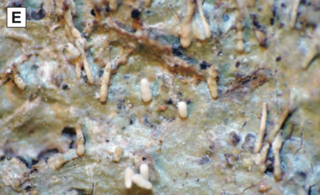
The Graphidaceae are a family of lichen-forming fungi in the order Graphidales. The family contains nearly a hundred genera and more than 2000 species. Although the family has a cosmopolitan distribution, most Graphidaceae species occur in tropical regions, and typically grow on bark.

Platygramme is a genus of lichen-forming fungi in the family Graphidaceae consisting of about 30 species. The genus was circumscribed by Antoine Laurent Apollinaire Fée in 1874.

Diorygma is a genus of lichen-forming fungi in the family Graphidaceae. The genus was circumscribed by Franz Gerhard Eschweiler in 1824. Species of the genus are widely distributed in tropical and subtropical regions of the world.

Acanthothecis is a genus of lichen-forming fungi in the family Graphidaceae. The genus was circumscribed by Frederick Edward Clements in 1909.

Myriotrema is a genus of lichen-forming fungi in the family Graphidaceae.
Chroodiscus is a genus of leaf-dwelling lichens in the family Graphidaceae. It was first introduced by Swiss lichenologist Johannes Müller Argoviensis in 1883 as a section of the genus Ocellularia. In 1890 he promoted it to generic status.

Acanthotrema is a genus of lichens in the family Graphidaceae. The genus was circumscribed by German lichenologist Andreas Frisch in 2006, with Acanthotrema brasilianum assigned as the type species. Acanthotrema species are commonly found in rainforests ranging from lowland to montane environments.
Topeliopsis is a genus of lichen-forming fungi in the family Graphidaceae.

Thelotrema is a genus of lichen-forming fungi in the family Graphidaceae, the family to which all taxa in the former Thelotremataceae now belong.
Phaeotrema is a genus of lichen-forming fungi in the family Graphidaceae. The genus was circumscribed in 1887 by Johannes Müller Argoviensis, with P. subfarinosum assigned as the type species.

Allographa leptospora is a species of script lichen in the family Graphidaceae. The lichen was first formally described in 1921 by Finnish lichenologist Edvard August Vainio as Graphis leptospora. The type specimen was collected in 1904 by German botanist Carl Curt Hosseus on Doi Suthep, where it was found growing on tree bark. Hosseus sent this and other lichens collected from Thailand to Vainio for identification. Robert Lücking and Klaus Kalb transferred it to the genus Allographa in 2018. In 2016, the lichen was reported from the Sintra Mountains, Portugal, which was its first documented occurrence in Europe.
Kalbographa is a genus of lichen-forming fungi in the family Graphidaceae. The genus was circumscribed in 2007 by lichenologist Robert Lücking with Kalbographa caracasana assigned as the type species. The genus name honours German lichenologist Klaus Kalb.
Carbacanthographis salazinica is a species of script lichen in the family Graphidaceae. Found in Australia, it was described as a new species in 2001 by lichenologist Alan Archer. The type specimen was collected by Archer in Conglomerate State Forest. Here the lichen was found growing on the bark of a palm tree. Its thallus is thin and grayish-green, with conspicuous white lirellae measuring 1–4 mm long. The specific epithet refers to salazinic acid, the presence of which is a distinguishing characteristic of this species. The lichen also has trace amounts of other secondary chemicals, including consalazinic acid, norstictic acid, and protocetraric acid. In 2005 Archer transferred the taxon to genus Carbacanthographis.
Cruentotrema is a genus of corticolous (bark-dwelling) lichens in the family Graphidaceae. It has seven species.

Robert Lücking is a German lichenologist. He earned his master's and PhD from the University of Ulm, focusing on the taxonomy, ecology, and biodiversity of foliicolous lichens. He has received numerous awards for his work, including the Mason E. Hale award for his doctoral thesis, the Augustin Pyramus de Candolle prize for his monograph, and the Tuckerman Award twice for his publications in The Bryologist. Since 2015, he has been serving as the curator of lichens, fungi, and bryophytes at the Berlin Botanical Garden and Botanical Museum, and several lichen species and a genus have been named in his honour.
Graphidales is an order of lichen-forming fungi in the class Lecanoromycetes. It contains 6 families, about 81 genera and about 2,228 species. Family Graphidaceae are the largest crustose family within Graphidales order comprising more than 2000 species, which are widely distributed in tropical and subtropical regions of the world.
Topeliopsis acutispora is a species of crustose lichen in the family Graphidaceae. It is found in New South Wales and southern Queensland (Australia), where it grows on bryophytes.
Allographa pedunculata is a species of script lichen in the family Graphidaceae, discovered in the Galápagos Islands. The species is characterized by its distinctly stalked lirellae and contains norstictic acid. It is similar to other species in the Graphis nuda species complex but has the longest ascospores in the group.
Pallidogramme is a genus of lichen-forming fungi in the family Graphidaceae. It has 8 species of corticolous (bark-dwelling), crustose lichens.








